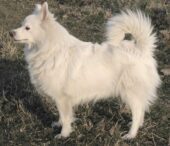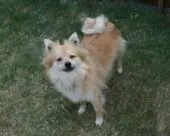Content |
|---|
History
The Spitz it is one of the oldest German domestic dog breeds, although its origins are not entirely clear. There is evidence that dogs Spitz lived together with humans ago 4.000 years. Due to its wide diffusion as a watchdog on farms and in the homes of the petty bourgeoisie, it also found its way into literature and painting..
Especially in rural areas, a German Spitz was ubiquitous in the old days as a house and garden dog. Smaller Spitz were popular as lap dogs with ladies.
The popularity of the Spitz decreased so much in the recent past that it was declared an endangered breed of pet in 2003.
Physical characteristics
All the German Spitz, regardless of size or color, they form a family and should have similar features and a typical lace look.
The Spitz impresses with his beautiful coat. The abundant undercoat and long top coat, straight and outstanding give them their unmistakable appearance. Particularly striking is the strongly mane-like collar around the neck and the bushy, furry tail., that is carried boldly on the back. The fox-like head with quick eyes and small, narrow, pointy ears give the Spitz its characteristic disturbing expression.. The body of the Spitz is square.
Measurements:
to) Wolfspitz / Keeshond : 49 cm ± 6 cm..
b) Grossespitz (Giant or Large Spitz) : 46 cm ± 4 cm..
c) Mittelspitz (Standard or Medium Spitz) : 34 cm ± 4 cm..
d) Kleinspitz (Miniature or Small Spitz) : 26 cm ± 3 cm..
and) Zwergspitz (Toy or Dwarf Spitz) / Pomeranian : 20 cm ± 2 cm..
(are undesirable specimens measuring less than 18 cm.).
Weight
Any variation in the size of the German Spitz should have a corresponding variation in weight.
Character and skills
One German Spitz has a reputation for being a chatterbox. In fact, the dogs bark a lot; for a guard dog, making a sound is a desirable characteristic, that today cannot be reconciled with all the neighbors.
A natural distrust, along with incorruptibility and loyalty, is inherent to German Spitz. This makes it predestined to be a watchdog that patrols its territory and reports suspicious incidents.. One German Spitz reliably defends the things entrusted to him. When not on guard, a is a very friendly and affectionate dog, sometimes a little possessive, who follows his humans closely and enjoys being petted. One German Spitz is generally regarded as a child.
The education and attitude of the German Spitz
With cheerful romp and docility, a German Spitzn is a dog that absolutely needs a task. Find your place as a working watchdog, but also as a companion and family dog. With lots of positive encouragement and loving consistency, breeding is not problematic and can also be managed if you have little experience with dogs.
for a German Spitz be respectful of animals, must be weather resistant: The Spitz it just feels really comfortable outdoors, either with sun, rain or snow. It is an ideal companion for runners, riders and cyclists. He is also an agility sports enthusiast. As the Spitz only has a weakly developed hunting instinct, does not tend to go its own way when outdoors and is easy to recover. It is less suitable for intensive accommodation, especially because he likes to bark a lot. Similar to the Poodle, the spitz is available in different sizes, from the Zwergspitz (Toy or Dwarf Spitz) / Pomeranian to Wolfspitz / Keeshond. The best known variant is the Mittelspitz (Standard or Medium Spitz) with a shoulder height of 34-38 cm and weighing up to 10 kg. Apart from its format, the types do not differ visually.
Caring for the German Spitz
Surprisingly, the fluffy coat of the Spitz does not require much grooming. The hair is dirt repellent, so an occasional brushing is enough. It also, a German Spitz it is very clean and cleans itself. Also in terms of health, the Spitz they are quite robust dogs.
Type and recognitions:
- FCI CLASSIFICATION: 97
- Group 5: Spitz and primitive types
- Section 4: European Spitz. Without working trial..
Federations:
- – FCI – Group 5 – Section 4 European Spitz. [simple_tooltip content=’The International Cynological Federation is the largest international federation of Kennel Clubs in the world. It is responsible for governing and promoting cynology, as well as the rules of dog breeding. consists of 95 member countries with their own pedigrees that train their judges. Each country dictates the norms of the native breeds of the same, which they are supported by the FCI. It is based in Thuin, Belgium.']ⓘ[/simple_tooltip]
FCI breed standard "German Spitz"
Alternative names:
1. Deutscher Spitz (English).
2. Spitz allemand (French).
3. Deutsche Spitze (German).
4. Deutsche Spitze (Portuguese).
5. Spitz alemán (español).
Photos
1- Szpic_miniatura at the national show in Rybnik – Stone to Pleple2000 / CC BY-SA
German Spitz varieties
to) Wolfspitz / Keeshond.
b) Grossespitz (Giant or Large Spitz) .
c) Mittelspitz (Standard or Medium Spitz).
d) Kleinspitz (Miniature or Small Spitz).
and) Zwergspitz (Toy or Dwarf Spitz) / Pomeranian.
European Spitz
1 Grossespitz (Giant or Large Spitz)
Although I do not necessarily suspect it at first glance, the Grossespitz (Giant or Large Spitz) it is also extremely robust and weather resistant. ... Read more
3 Kleinspitz (Miniature or Small Spitz)
The Kleinspitz (Miniature or Small Spitz) he is a loving and attentive dog, that is very people-oriented. ... Read more
4 Mittelspitz (Standard or Medium Spitz)
The Mittelspitz (Standard or Medium Spitz) is by nature a bit like the old guard dog. ... Read more
5 Pomeranian
The Pomeranian very active, independent, Intelligent, brave and loyal. education and
... Read more







One more remark about buying a Pomeranian: In addition to the "usual" items, which must be considered before buying a dog, you should only buy a Pomeranian from a breeder. Pomeranians are one of the domestic breeds that are particularly endangered due to heredity. Hence the right one selection even more important than other races. Many breeders also offer their dogs on online platforms such as e.g. https://trovas.ch/?title=pomeranian an. As an animal rights activist, I recommend it, that you always pick up the dogs personally. Be careful when buying cheap dogs, which are handed over at a rest area or other dubious environment. These are usually dog dealers with mostly sick Pomeranians!
This is a KLEINSPITZ not a Pomeranian..
The Pome is even smaller.
Hello I am interested in your page I want to buy a toy that e pomerania seen by internet and is like a Teddy but fail to find that dog, was if I you could help comparalo a greeting.